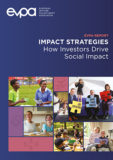“Investing for Impact | The EVPA Survey 2017/2018” is the result of the analysis of data collected from 110 venture philanthropy and social investment (VP/SI) organisations across Europe, either focussing exclusively on social return, or seeking a social return alongside a financial one, and adopting the core practices of the VP approach (i.e. tailored financing, non-financial support and impact measurement and management).
Key Findings
For 2018, European VP/SI organisations report growing budgets coming from a diverse group of funders, more stable and professional human resources, and an improved pipeline management. Relevant key data and trends include:
- VP/SI organisations help social purpose organisations (SPOs) get through the early stages of their growth, with half of the respondents providing on average €200,000 or less per SPO.
- Equity is the most patient form of capital with almost all respondents using this financial instrument to support SPOs for more than four years.
- Loans are the most deployed financial instrument in the VP/SI space, followed by grants, equity, and hybrid instruments (only 5%).
- The large majority of VP/SI organisations with positive financial return expectations, seek moderated financial returns: respondents deploying equity having expectations not exceeding +10%, and those using debt expecting returns from 0% to +5%.
- Grants are largely used to support SPOs at incubation and start-up.
Another interesting trend is the growth registered in Central Eastern Europe (CEE) with a 7% of the resources allocated there, compared to the 2% of two years ago. This result is likely to reflect the increased number of organisations coming from this region and investing locally, also thanks to the work EVPA is carrying out in this region since 2014.
Download the infographic (pdf)
Download the full report (pdf)
Guide “Impact Strategies – How Investors Drive Social Impact”
EVPA also published the guide “Impact Strategies – How Investors Drive Social Impact”. This guide explores how various types of capital providers combine their social impact objectives, financial returns expectations and risk appetite to sustain real social impact.
As the impact ecosystem is rapidly evolving and changing, attracting more resources to social purpose organisations, more actors enter the space, and it is becoming more challenging to define and distinguish the various investment approaches.
This report is an important step forward in the process of clearing the air around social impact and financial return expectations and risk appetite. It identifies two main approaches: “Investing for Impact” and “Investing with Impact” – both aiming to generate social impact with different mind-sets. Differentiating them allows to make both approach more transparent on intentions, better align shareholders, manage expectations towards investees, and create the right setting to collaborate with other types of capital providers. Both strategies are therefore very valuable, exist next to each other and support social innovations at different stages of their development.
This research is supported by a series of practical cases from experienced practitioners, and describes in detail the characteristics of investors for impact and their journey through social impact sought, financial returns aimed, and social and financial risks taken.







